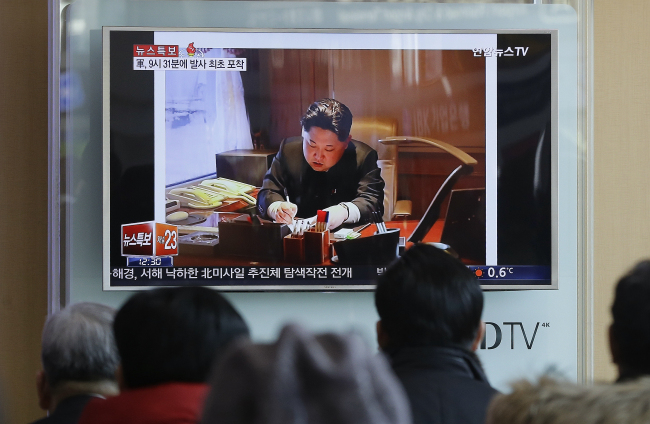Officials and observers in South Korea and other countries are bracing for North Korea’s next widely expected nuclear test before early May, but questions remain on the credibility of the reclusive country’s claims of its advanced nuclear strike capacity.
Pyongyang’s leader Kim Jong-un has publicly claimed his engineers have successfully miniaturized the nuclear warheads to be mounted onto ballistic missiles, along with acquiring reentry technology for the intercontinental ballistic missiles.
Pyongyang’s leader Kim Jong-un has publicly claimed his engineers have successfully miniaturized the nuclear warheads to be mounted onto ballistic missiles, along with acquiring reentry technology for the intercontinental ballistic missiles.

If confirmed, this would mean that the North now has the capacity to strike the contiguous U.S. with its KN-08 ICBM, which is estimated to have a range of up to 12,000 kilometers.
But experts say Kim’s claims are highly unlikely to be true as the KN-08 missiles have not been tested yet. Last week, the North’s botched attempt to fire an intermediate-range Rodong missile -- which had been deployed for use since 2007 but never actually fired -- for the first time has put even more doubts on its self-proclaimed ability to carry out nuclear strikes.
The North has been seeking to acquire a nuclear weapon as an asymmetrical threat against the Seoul-Washington alliance.
Kim’s boastful words notwithstanding, assessing the extent of the North’s nuclear capacity has been likened to putting together a jigsaw puzzle of fragmented and unconfirmed clues.
South Korea’s military has maintained that while it is true that the North has made “considerable strides” in terms of miniaturizing the nuclear warheads, it is not yet at the level of mounting it onto a ballistic missile. While standards for miniaturization vary per country, the military’s assessment is that for North Korean weapons this involves making the warhead weigh 1 ton or less.
But U.S. military and experts have been more open to such possibility. On Tuesday, U.S. northern commander Adm. William Gortney said that he assesses that the North is able to “miniaturize a nuclear weapon and range the homeland with that warhead,” although he acknowledged that the probability was low.
Jeffrey Lewis, at the James Martin Center for Nonproliferation Studies, recently assessed there is a possibility that North Korea has developed a compact fission device weighing about 200 to 300 kilograms.
A military official that declined to be named said that while such assumptions can be considered among possibilities, a nuclear warhead test or an accurate flight test of the missiles is needed to confirm such theories.
Both South Korea and the U.S. stand on common ground in not recognizing North Korea as a nuclear weapon state.
There has been speculation the North may have succeeded in developing a booted fission weapon, which adds hydrogen isotopes that fuse and release neutrons upon an explosion to make the weapon more efficient. U.K.-based defense information provider IHS Jane’s suspected that this device was detonated during the North’s Jan. 6 nuclear test, of which Pyongyang claimed was a hydrogen bomb test.
A military expert with knowledge about the North’s nuclear tests said there is a possibility that the North’s fifth nuclear test would use the boosted weapon.
“If North Korea decides to stay at the level of boosted fission weapons like India and Pakistan, no additional tests will be necessary (upon success). But as Kim has vowed to add hydrogen bombs to his arsenal, additional tests will likely follow,” he said, explaining that boosted weapons and hydrogen weapons essentially are based on different principals.
The North is currently presumed to have about 40 kilograms of plutonium. The military has assessed that the North would be able to create a nuclear weapon with about six kilograms of the material.
South Korea’s Defense Minister Han Min-koo has said that the North can conduct the next nuclear test “any time the leadership decides to.”
North Korea watch website 38 North said in a report Thursday that satellite images of the North’s Punggye-ri nuclear test site from April 19 shows limited vehicle and equipment activities at the north portal. While the evidence does not definitively indicate an imminent test, it pointed out that Pyongyang has already demonstrated with its January test that it can conduct detonation on short notice while hiding indicators of the preparations.
The military expert on North Korean nuclear tests said the equipment must be put inside the underground test sites about a week before the actual test to make sure they are fully operational.
North Korean Foreign Minister Ri Su-yong arrived in New York on Wednesday, making his first trip to the United Nations since the rising inter-Korea tensions sparked by the January nuclear testing.
There have been speculations that Ri will hold talks with U.S. officials, possibly resuming peace talks in the region. Earlier this month, the hermit kingdom briefly mentioned the need for talks, while berating Seoul and Washington at the same time.
But the U.S. State Department dismissed such possibility, urging the North to commit to denuclearization and stop what it called provocative activities.
By Yoon Min-sik (minsikyoon@heraldcorp.com)
But experts say Kim’s claims are highly unlikely to be true as the KN-08 missiles have not been tested yet. Last week, the North’s botched attempt to fire an intermediate-range Rodong missile -- which had been deployed for use since 2007 but never actually fired -- for the first time has put even more doubts on its self-proclaimed ability to carry out nuclear strikes.
The North has been seeking to acquire a nuclear weapon as an asymmetrical threat against the Seoul-Washington alliance.
Kim’s boastful words notwithstanding, assessing the extent of the North’s nuclear capacity has been likened to putting together a jigsaw puzzle of fragmented and unconfirmed clues.
South Korea’s military has maintained that while it is true that the North has made “considerable strides” in terms of miniaturizing the nuclear warheads, it is not yet at the level of mounting it onto a ballistic missile. While standards for miniaturization vary per country, the military’s assessment is that for North Korean weapons this involves making the warhead weigh 1 ton or less.
But U.S. military and experts have been more open to such possibility. On Tuesday, U.S. northern commander Adm. William Gortney said that he assesses that the North is able to “miniaturize a nuclear weapon and range the homeland with that warhead,” although he acknowledged that the probability was low.
Jeffrey Lewis, at the James Martin Center for Nonproliferation Studies, recently assessed there is a possibility that North Korea has developed a compact fission device weighing about 200 to 300 kilograms.
A military official that declined to be named said that while such assumptions can be considered among possibilities, a nuclear warhead test or an accurate flight test of the missiles is needed to confirm such theories.
Both South Korea and the U.S. stand on common ground in not recognizing North Korea as a nuclear weapon state.
There has been speculation the North may have succeeded in developing a booted fission weapon, which adds hydrogen isotopes that fuse and release neutrons upon an explosion to make the weapon more efficient. U.K.-based defense information provider IHS Jane’s suspected that this device was detonated during the North’s Jan. 6 nuclear test, of which Pyongyang claimed was a hydrogen bomb test.
A military expert with knowledge about the North’s nuclear tests said there is a possibility that the North’s fifth nuclear test would use the boosted weapon.
“If North Korea decides to stay at the level of boosted fission weapons like India and Pakistan, no additional tests will be necessary (upon success). But as Kim has vowed to add hydrogen bombs to his arsenal, additional tests will likely follow,” he said, explaining that boosted weapons and hydrogen weapons essentially are based on different principals.
The North is currently presumed to have about 40 kilograms of plutonium. The military has assessed that the North would be able to create a nuclear weapon with about six kilograms of the material.
South Korea’s Defense Minister Han Min-koo has said that the North can conduct the next nuclear test “any time the leadership decides to.”
North Korea watch website 38 North said in a report Thursday that satellite images of the North’s Punggye-ri nuclear test site from April 19 shows limited vehicle and equipment activities at the north portal. While the evidence does not definitively indicate an imminent test, it pointed out that Pyongyang has already demonstrated with its January test that it can conduct detonation on short notice while hiding indicators of the preparations.
The military expert on North Korean nuclear tests said the equipment must be put inside the underground test sites about a week before the actual test to make sure they are fully operational.
North Korean Foreign Minister Ri Su-yong arrived in New York on Wednesday, making his first trip to the United Nations since the rising inter-Korea tensions sparked by the January nuclear testing.
There have been speculations that Ri will hold talks with U.S. officials, possibly resuming peace talks in the region. Earlier this month, the hermit kingdom briefly mentioned the need for talks, while berating Seoul and Washington at the same time.
But the U.S. State Department dismissed such possibility, urging the North to commit to denuclearization and stop what it called provocative activities.
By Yoon Min-sik (minsikyoon@heraldcorp.com)








![[Hello India] Hyundai Motor vows to boost 'clean mobility' in India](http://res.heraldm.com/phpwas/restmb_idxmake.php?idx=644&simg=/content/image/2024/04/25/20240425050672_0.jpg&u=)











